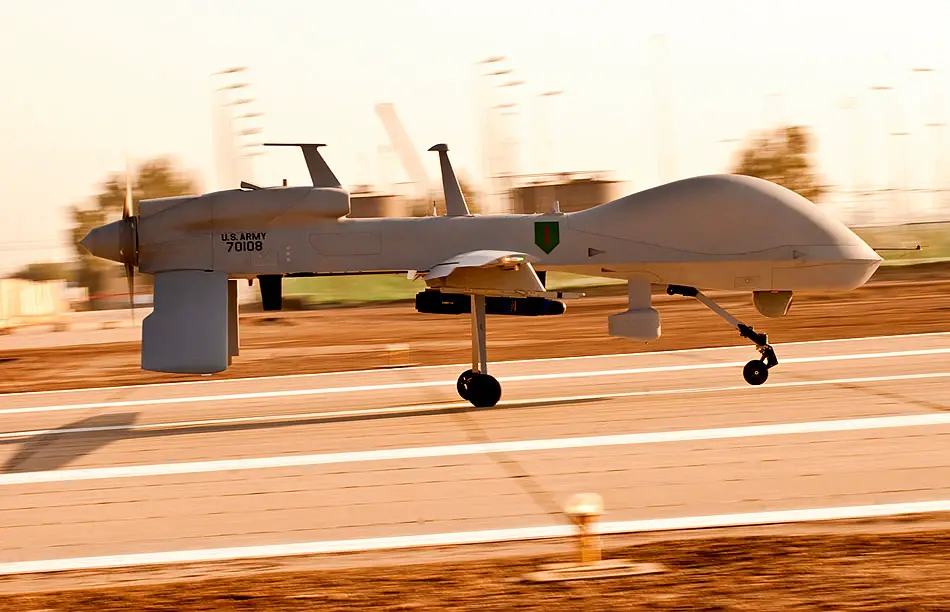
From the U.S. Army:
The U.S. Army’s Gray Eagle unmanned aircraft system recently completed a successful initial operational testing and evaluation at the Army’s National Training Center at Fort Irwin, Calif.
During the initial operational testing and evaluation, or IOT&E, the Gray Eagle platform was operated from Edwards Air Force Base, Calif., and employed in an operational and realistic way in support of a brigade combat team rotation at NTC, explained John Moltenberry, military test plans analyst, U.S. Army Operational Test Command, Army Test and Evaluation Command.
The basic thrust of the IOT&E is to assess the degree to which a given platform or technology meets its designated requirements, typically as a way to inform anticipated full-rate production decisions, he said.
”We collect data and provide data to the evaluators. The evaluator then does his analysis based on that data.
The idea is to exercise the system against a specified set of requirements such as day and night operations, operational tempo, maintenance man hours and mission load — essentially assessing the types of missions the Gray Eagle would be most likely to perform,” Moltenberry added. “Some of the requirements might be the ability to remain on station for a given number of hours or demonstrate an ability to acquire and engage a target.”
Operators can control the Gray Eagle through the use of satellite communications — which allow for “beyond-line-of-sight” missions — or through tactical common data link line-of-sight signals, Moltenberry explained.
Timothy Baxter, the project manager for unmanned aircraft system, UAS, said the IOT&E verified that the Gray Eagle platform was effective, operationally suitable and meeting survivability and force protection key performance parameters. He also added that the beyond low-rate-initial-production report included a handful of worthwhile recommendations.
”The recommendations are associated with improving tactics, techniques and procedures, improving doctrine with respect to UAS, and then next-war preparation,” Baxter said.
Baxter explained next-war preparation in terms of examining the implications regarding what the much-discussed Air-Sea Battle concept might mean for UAS development and deployment.
Among other things, he said, Air-Sea Battle-type deployments might require UAS to operate against hybrid or “near-peer” threats as opposed to performing primarily counter-insurgency operations.
”We’ll be returning to mobile operations because we have been kind of forward operating base-centric over the last 10 years or so,” he said. “An expeditionary and mobile operations mindset will be our focus as we develop a five-year plan for product improvements across the board.”
Among the tactics, techniques and procedures, known as TTPs, being refined is something called manned/unmanned teaming, a technology wherein manned aviation platforms such as helicopters can share information, data and full-motion video in real time with nearby UAS; explained Baxter and Richard Kretzschmar, the Army’s deputy project manager for unmanned aerial systems.
The recent Gray Eagle IOT&E afforded the technology an occasion to demonstrate, test and utilize this latest iteration of the technology.
”We are maturing the manned/unmanned teaming capabilities associated with the Gray Eagle,” said Baxter.
”We’re not resting on our laurels and have a robust interoperability profiles. As we learn more about these TTPs and how we want to fight, we can be more efficient,” said Kretzschmar.
The IOT&E also further established and refined standardized procedures and protocols for what’s called the one system remote video terminal, or OSRVT. The terminal is a small, mobile technology that displays real-time full-motion video to warfighters, said Lt. Col. James Kennedy, the product manager for common systems integration.
In total, the OSRVTs are designed to work in tandem with the UAS system and its sensors to provide the warfighter with substantially enhanced capability in combat. The sensors on the Gray Eagle, for instance, can be of greater value and relevance to Soldiers when they are increasingly able to be viewed in a wide range of scenarios, Baxter and Kennedy said.


